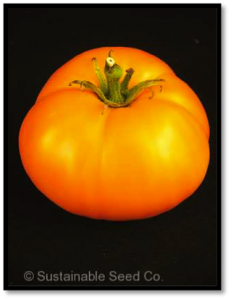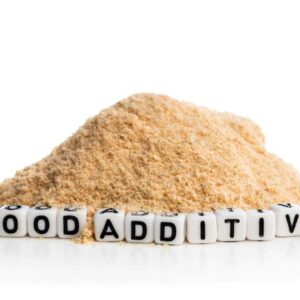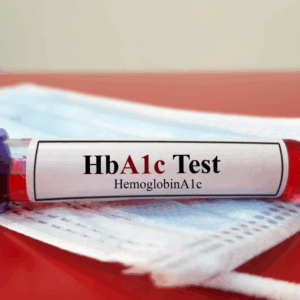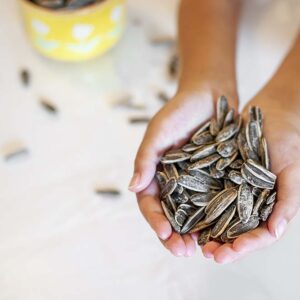
You Say Tomato, I Say (Tangerine) Tomahto
Toasted white bread. Mayo. American cheese. Salt, pepper, and two thick slices of fresh-picked red ripe tomato.
Growing up, that was our family’s classic summer sandwich. On a hot day, there really wasn’t anything better.
We now know that the white bread, mayo, and processed cheese are best avoided or eaten only as a very special treat. But the tomato? That’s one of the healthiest summer fruits you can find. And if you grow it yourself or get it local and organic, you really can’t go wrong.
Thanks to the clever marketing of Heinz ketchup, many people are aware that it’s the lycopene content of tomatoes that researchers believe hold most of their health benefits.
Lycopene has been shown to have strong antioxidant properties, and numerous studies have linked diets high in lycopene-rich foods, like tomatoes, to reduced risk of cancer, heart disease, and eye diseases. And it’s been found to be especially protective against prostate cancer.
Just last week, I wrote about how women who ate lycopene-rich tomato paste for 12 weeks experienced protection against sunburn and sun damage compared with women who did not eat the tomato paste.
And since then, I’ve come across two more studies showing lycopene-rich foods can help protect against sunburn and sun damage. (1) (2)
Eating red tomatoes is a great way to get lycopene; they supply about 80% of lycopene in the American diet. And unlike with many other vitamins and phytonutrients, cooking tomatoes actually increases the bioavailability of lycopene (meaning how much you absorb). Cooking tomatoes in olive oil can increase the bioavailability of lycopene even further. (3)
And now a new study published in Molecular Nutrition & Food Research suggests there is an even better source of lycopene than red tomatoes: the bright orange tangerine tomato. (4)

Tangerine tomato
In this study, researchers gave participants a meal containing either tangerine tomato juice or red tomato juice and then measured their blood levels of lycopene. Then after a washout period, the participants switched to the other type of tomato and the researchers again measured their lycopene blood levels.
Surprisingly, the tangerine tomatoes boosted blood levels of lycopene about 8.5-fold better than the red tomatoes!
It was a small study — only 11 participants — and the researchers noted there were a lot of individual differences in absorption among the study participants.
But another study published in back in 2009 had similar findings. In this study, 21 men and women were fed either red or tangerine tomato chili for one week. Again, the tangerine tomatoes boosted lycopene levels greater than the red tomatoes. The researchers also found that while both types of tomatoes decreased markers of oxidative damage, the tangerine tomatoes produced better results. (5)
The reason for the enhanced bioavailability in tangerine tomatoes appears to be due to the form of lycopene in them: Red tomatoes contain mostly trans-lycopene, while tangerine tomatoes have more tetra-cis-lycopene.
So where can you find tangerine tomatoes? I can’t say I’ve ever seen them in any chain grocery stores, so checking for them at a local farmer’s market is your best bet. Shopping at the farmer’s market is a great idea, anyway, as the produce is going to be much fresher and nutrient dense than what you get at the grocery store. If you can’t find them anywhere, you can buy tangerine tomato seeds online and plant them in your garden next year.
Either way, be sure to take advantage of fresh local tomatoes this summer. They’re a great source of antioxidants that can help protect you against free radicals that can damage DNA and lead to cancer. Tomatoes are also rich in vitamins C and A and are a good source of potassium, which helps keep blood pressure levels in the healthy range.
Stew them in some oil to make a tomato sauce. Layer the sauce on zucchini sliced length-wise, top with some parmesan cheese and bake for a low carb “pizza.” Or make a caprese salad: slice them up, layer with fresh organic mozzarella cheese, drizzle with balsamic and olive oil, and top with fresh chopped garlic and basil.
Have you ever tried or grown tangerine tomatoes? Let me know! livingwelldaily@lfb.org
To living well,
Jasmine LeMaster
View More Free Articles
"Invisible" Food Ingredients SABOTAGE Blood Sugar
If you’re trying to keep your blood sugar in check, you know the drill. Cut way back on sugar in your diet. While you’re at it, rein in your fat intake too, which can lead to insulin resistance. And don’t forget the extra calories—they add up fast and can sabotage your blood sugar control. But...
The Alarming Microplastic Secret Hidden in Your Chewing Gum
Today I want to honor and thank mothers and mother figures whose caring hearts have guided us through life’s journey. Your love has shaped generations. Happy Mother’s Day! That pack of gum in your pocket may be doing far more than just freshening your breath. A disturbing new study finds chewing gum is a surprising...
Plant Compound SLASHES A1c Levels in 12 Weeks
Diabetes is skyrocketing in the United States. And the trend shows no sign of slowing down. The projected number of adults with diabetes is expected to increase from 22.3 million (9.1 percent) in 2014 to 39.7 million (13.9 percent) in 2030, and further to 60.6 million (17.9 percent) by 2060. That’s a massive 165 percent...
Two-Week Diet Switch Transforms Your Health
You know how you feel sluggish and “off” after a vacation filled with fast foods and processed snacks? Well, it’s not all in your head (or merely guilt). When you switch to an unhealthy Western-style diet, there are physical consequences—and they kick in faster than you might think… The Western diet is characterized by ultra-processed...
WARNING—Your Water Bottle Is Hiding a Disgusting Secret
Recently, a few people have asked me if it’s true that their water bottle has more germs than a toilet seat. It’s a shocking comparison that’ll make you think twice about everyday objects you use without much thought. So, is this claim true? Well, I must warn you that you might not like the answer…...
Research Reveals 3-for-1 Brain Protection "Checklist"
Age-related brain diseases—including stroke, dementia, and depression—threaten our quality of life. They can take the shine right out of your Golden Years. But you don’t have to take these threats lying down. While there are no guarantees in life, there are steps you can take to turn the odds in your favor—especially when it comes...
Mailbag: Your “Healthy Diet” Might Leave You Running on Empty
“Do supplements really work?” Hopeful Skeptic Hi Hopeful, That’s a fantastic question! It gets straight to the heart of a vital fact about human biology. Our bodies are incredible machines. But they don’t work in a vacuum. They require outside help to function. For example, they can’t manufacture most vitamins and minerals on their own....
Forgotten 80s Superfood Reemerges as Artery Superstar
Do you remember when vitamin E was the talk of the town? This common nutrient had a surge of popularity in the 80s and 90s. But now I can’t remember the last time I had a patient ask me about it. Well, it turns out this forgotten 80s superfood deserves another moment in the spotlight....
Strokes CAN Strike Twice—This Simple Fix Cuts Your Risk 20%
They say lightning never strikes twice in the same place. But that old adage couldn’t be further from the truth when it comes to strokes. If you’ve had a stroke, you might think you’re out of the woods once you recover. But the reality is far different… A comprehensive study published in JAMA revealed the...
Can Your Diet Defend Your Brain From Aging?
Our brains work hard every day, helping us solve problems, create memories, and connect with loved ones. But as we age, they face new challenges that can quietly chip away at our vitality. One of those challenges? The buildup of iron. Though iron is essential for many functions, too much can harm your brain, contributing...









